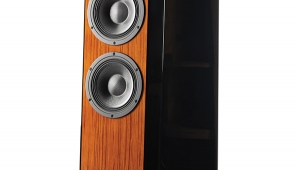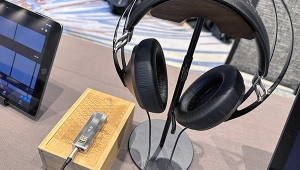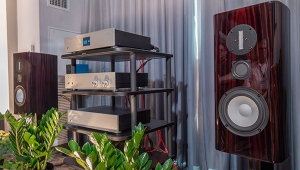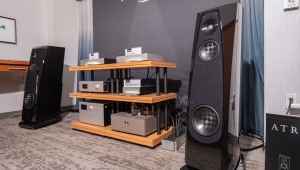| Columns Retired Columns & Blogs |
Infinity Prelude MTS loudspeaker Page 2
The $8000/pair ($10,000 as of 2002) (with powered subwoofer) Prelude system is designed to produce as flat a full-range frequency response as possible on-axis, and uniform, controlled dispersion off-axis. This is important: the research shows that we are incredibly sensitive to resonant peaks, and that these peaks create the "colorations" that, for the most part, help us decide if a speaker sounds "good" or "bad." Generally speaking, the higher the Q of the resonance (the narrower the peak in the frequency domain), the greater the amplitude must be of that peak for us to hear it. Toole's research demonstrates that we can perceive low-Q resonances (ie, those that cover a wider frequency range) that deviate as little as 1.5dB from flat on orchestral material, and as little as 0.3dB on pink noise.
We all know that resonances are common in drivers and loudspeakers, and especially in rooms. The four-way, full-range Preludes incorporate a single-band parametric bass-equalization scheme (Infinity's R.A.B.O.S., or Room Adaptive Bass Optimization System) to deal with low-frequency room "bumps," and stiff, lightweight, effectively damped, low-resonance Ceramic Metal Matrix Diaphragm (C.M.M.D.) drivers of aluminum coated on both sides with ceramic. These drivers are designed to have uniform dispersive characteristics so that direct and reflected sounds maintain similar timbral balances.
The graphs showing the ultra-low resonances and distortion characteristics of these C.M.M.D. drivers are truly astonishing. In addition, the impedance curve of the system is said to be 4 ohms, ±1 ohm across the full audio bandwidth—itself an impressive engineering feat, and super-critical when driving the tower section with tubes, or any amplifier with a high output impedance.
As we've all seen in Stereophile's published measurements, if an amp with high output impedance is mated to a speaker with a widely fluctuating impedance, the amp's frequency response will pattern itself after the speaker's impedance curve. The research shows that this is easily heard. It is the loudspeaker that is causing the amplifier to "sound," not vice versa.
Do I Want My Myths Shattered?
You may ask why, after a day of heavy pummeling by Floyd Toole—a CD-loving scientist who relies strongly on measurements, who cuts mystics and "observational reviewers" no slack, and whose research proves that when we can see what we are about to hear, we form hopelessly prejudicial responses—I still wanted to review these speakers. You also may ask why he'd want them reviewed by someone like me—or by any "observational" reviewer, for that matter. Actually, he may not, given some of the disparaging things he's written about nonscientific, "casual" reviewing in his published research.
There may be a single answer to both questions: In discussing the bass-equalization feature, Toole admitted that attempts at this made in the 1970s yielded great measurements but, according to the golden-eared, "bad bass." And guess what? The ears were right. The observational types heard things that the primitive measuring devices of the time couldn't. Today's gear shows—and Toole showed us—that 1/3-octave equalization mutilated bass performance in ways that were then unmeasurable but clearly audible. So if I didn't like the sound of these "near-perfect"-measuring loudspeakers, I had an out: I was hearing things not yet measurable.
Prelude
The Prelude MTS consists of a powered (850W), side-firing subwoofer housed in a curvaceously compact enclosure of veneered MDF; and a tall, narrow, sleek-looking aluminum tower containing a 1" dome tweeter set into a flared "waveguide" depression designed to smooth the integration of the midrange driver's upper response and the tweeter's lower, a 3*" midrange cone, and four 5*" mid/woofer cones. The drivers in the tower cross over at 300Hz and 2kHz at 24dB/octave, while the crossover to the subwoofer is set at 80Hz. A switch on the base of the Prelude tower allows it to be set to Full-Range or High-Pass. (I used the speakers set to Full-Range.)
The tower can be mounted atop the woofer, as mine was configured, or placed on a separate stand. The sub's facade features a brushed-aluminum accent designed to blend cosmetically with the tower. The versatile Prelude can easily be configured to accept preamp line- or speaker-level signals, and can be used in two-channel music or multichannel home-theater applications. There's a dedicated center-channel variant, and the tower can even be attached to the wall with special brackets.
Mounting the tower atop the woofer requires the removal of a cosmetic top plate, under which is a recessed pair of five-way binding posts, and a series of threaded holes for the actual mounting bracket and a pair of large guide pins. Dual male, gold-plated banana plugs provide the electrical connection between the woofer's binding posts and a set at the bottom of the tower. Dual banana plugs? I didn't much go for that; if I were buying Preludes, I'd find a better way to get the signal to the tower, and pronto.
- Log in or register to post comments




































